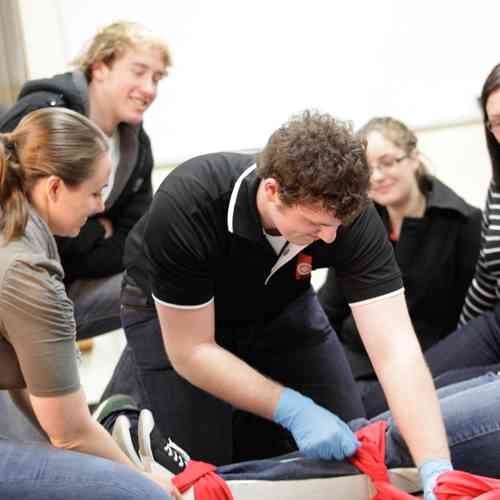Introduction
In today's hectic workplace, security is critical. Organizations are significantly acknowledging the value of creating a safe area for employees. Among the most important components of work environment safety and security training is first aid and CPR (Cardiopulmonary Resuscitation) programs. These training courses not only equip workers with Mackay CPR skills training vital life-saving skills but also promote a culture of security within the company. In this article, we will certainly look into the myriad reasons why office safety training should include first aid and mouth-to-mouth resuscitation training courses, highlighting their relevance in enhancing workplace safety.
Why Workplace Safety and security Training Ought To Consist Of Emergency Treatment and CPR Courses
The assimilation of emergency treatment and mouth-to-mouth resuscitation training courses right into workplace safety training has far-reaching benefits. They outfit workers with the expertise and skills required to respond properly to clinical emergency situations, lower recuperation time for hurt individuals, and potentially conserve lives. Moreover, having actually educated employees on-site can instill confidence among workers and guarantee them that their wellness is prioritized.
Understanding First Aid
First aid describes the prompt treatment provided to a private suffering from a minor or significant ailment or injury up until professional medical aid shows up. Understanding fundamental first aid concepts can make a significant distinction in emergency situations.
Key Elements of First Aid
Assessment: The capacity to evaluate a scenario rapidly can help establish the appropriate activities needed. Stabilization: Understanding just how to support a wounded person avoids further harm. Communication: Properly interacting with emergency solutions is critical for prompt assistance.The Importance of CPR
CPR is a life-saving strategy used in emergencies when a person's heart beat or breathing has actually quit. It involves chest compressions and rescue breaths to maintain blood flow and oxygenation up until expert help arrives.
How CPR Works
- Chest Compressions: These assist circulate blood throughout the body. Rescue Breaths: These provide oxygen to the lungs.
Benefits of Emergency treatment and CPR Certification
Obtaining an emergency treatment certification or completing CPR programs comes with various benefits, both for people and organizations.
Enhanced Employee Confidence: Workers feel more protected understanding they possess life-saving skills. Reduced Recovery Time: Quick feedback via emergency treatment can result in better results for damaged individuals. Compliance with Regulations: Numerous sectors need licensed workers as part of their health and wellness regulations.Creating a Society of Safety And Security Via Training
Implementing first aid and CPR training cultivates a society that focuses on staff member wellness.
Encouraging Teamwork
Training sessions frequently include team-building exercises that boost collaboration among employees.
Building Depend on In between Staff members and Management
When administration purchases worker training, it shows dedication to their health and wellness, bring about increased morale.
First Aid Gushes vs. CPR Courses: What's the Difference?
While both types of courses are crucial, they focus on various skill sets.
First Help Courses
These programs cover a variety of topics beyond simply cardiac emergencies, consisting of:
- Wound care Burns Choking
CPR Courses
CPR programs particularly concentrate on methods connected to cardiac arrest situations, emphasizing:
- Adult CPR Child/ infant resuscitation Use of an Automated External Defibrillator (AED)
Choosing the Right Training Provider
Not all training suppliers are developed equal; therefore, selecting one that satisfies your company's needs is critical.
Accreditation Matters
Ensure that your chosen service provider offers recognized courses acknowledged by pertinent authorities.
Instructor Experience
Consider teachers' qualifications; seasoned trainers usually give richer discovering experiences through real-world examples.
Incorporating First Aid right into Workplace Safety Policies
Organizations need to integrate emergency treatment requirements into their broader safety plans for extensive coverage.
Regular Training Updates
Conducting normal refresher courses makes certain that knowledge continues to be current among employees.
Creating Emergency situation Reaction Plans
Having clear strategies in place can lead skilled employees throughout emergencies.

Legal Effects of First Aid Training in the Workplace
Employers have lawful duties pertaining to office safety; implementing emergency treatment training can help alleviate dangers associated with non-compliance.


Negligence Claims
Failure to offer ample training may leave employers vulnerable to lawsuits if an occurrence occurs as a result of lack of preparedness.
FAQ Section
What is included in a common first aid course?- A typical emergency treatment course consists of guideline on analyzing injuries, dealing with injuries, taking care of burns, dealing with choking incidents, and doing CPR if necessary.
- Most CPR programs last in between 4-- 6 hours depending upon whether it's standard or advanced training.
- While not always legitimately mandated, having licensed team member can substantially improve office security standards.
- Many certified organizations use on the internet revival choices for emergency treatment certificates which include analyses via video conferencing.
- Yes, industries such as building and construction, health care, education and learning, and production usually have regulative demands necessitating skilled personnel on site.
- It's suggested that employees participate in correspondence course every 2 years or sooner if there are substantial modifications in treatments or regulations.
Conclusion
To sum up, integrating first aid and mouth-to-mouth resuscitation into office safety training is not merely a choice yet a necessity in today's work environments where emergency situations can develop anytime. Organizations benefit tremendously from having actually trained personnel all set to respond successfully during situations while cultivating an ambience where employee health takes precedence over all else. For that reason, it comes to be apparent why workplace security training ought to consist of emergency treatment and CPR training courses-- they save lives while promoting an aggressive technique toward health and safety standards within organizations throughout various sectors.
By focusing on such crucial training initiatives-- emergency treatment certifications gotten via trustworthy suppliers together with functional hands-on experience-- business can substantially enhance their general emergency preparedness levels while additionally developing stronger teams with the ability of taking on any type of situation head-on!